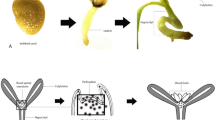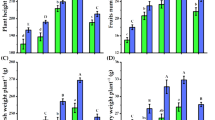Abstract
Plumbago zeylanica Linn. is an important medicinal plant from south east Asia. Roots of this plant are reported to have several phytochemicals, among which plumbagin is the most important compound that is synthesized by polyketide synthase using acetyl-CoA as a precursor. In the present study plumbagin content in roots of the plants collected from thirteen phyto-geographical regions of India were analysed by using high performance liquid chromatography. The present results suggested genotypic variations in plumbagin content among populations of Plumbago. Highest amount was detected in plants from Coimbatore, Tamil Nadu and lowest was found in plants from Kolli hills, Tamil Nadu. Seasonal variation was also observed in the synthesis of plumbagin in Plumbago plants. Expression analysis of polyketide synthase gene in roots was studied using Quantitative real time polymerase chain reaction to get better insight into its role in plumbagin synthesis. Results showed that expression of polyketide synthase gene is correlated with the level of plumbagin content in the roots of the plants.


Similar content being viewed by others
References
Pant M, Lal A, Rana S, Rani A (2012) Plumbago zeylanica L.: a mini review. Int J Pharmaceut Appl 3(3):399–405
Anonymous (1989) A dictionary of Indian raw materials and industrial products. The wealth of India. CSIR, New Delhi, pp 2163–2164
Tilak JC, Adhikari S, Devasagayam TP (2004) Antioxidant properties of Plumbago zeylanica, an Indian medicinal plant and its active ingredient, plumbagin. Redox Rep 9:219–227
Kavimani S, Ilango R, Madheswaran M, Jayakar B, Gupta M, Majumdar UK (1996) Antitumor activity of plumbagin against dalton’s ascitic lymphoma. Indian J Pharm Sci 58:194–196
Padhye S, Dandawate P, Yusufi M, Ahmad A, Sarkar FH (2010) Perspectives on medicinal properties of plumbagin and its analogs. Med Res Rev 32(6):1131–1158
Chopra RN, Nayar SL, Chopra IC (1996) Glossary of Indian medicinal plants. NISCOM Publishers, New Delhi, pp 55–60
Kuo PL, Hsu YL, CY C (2006) Plumbagin induces G2-M arrest and autophagy by inhibiting the AKT/mammalian target of rapamycin pathway in breast cancer cells. Mol Cancer Ther 5(12):3209–3221
Hafeez BB, Zhong W, Mustafa A, Fischer JW, Witkowsky O, Verma AK (2012) Plumbagin inhibits prostate cancer development in TRAMP mice via targeting PKCε, Stat3 and neuroendocrine markers. Carcinogenesis 33(12):2586–2592
Hafeez BB, Jamal MS, Fischer JW, Mustafa A, Verma AK (2012) Plumbagin, a plant derived natural agent inhibits the growth of pancreatic cancer cells in in vitro and in vivo via targeting EGFR, Stat3 and NF-jB signaling pathways. Int J Cancer 131:2175–2186
Durand R, Zenk MH (1974) The homogentisate ring-cleavage pathway in the biosynthesis of acetate-derived naphthoquinones of the Droseraceae. Phytochemistry 13:1483–1492
Livak K, Schmittgen T (2001) Analysis of relative gene expression data using real-time quantitative PCR and the 2-[Delta][Delta]CT method. Methods 25:402–408
Panda S Morpho-genetic diversity of Plumbago zeylanica L. populations from India. Dissertation, University of Pune
Kumar J, Verma V, Goyal A, Shahi AK, Sparoo R, Sangwan RS, Qazi GN (2009) Genetic diversity analysis in Cymbopogon species using DNA markers. Plant Omics J 2(1):20–29
Fico G, Spada A, Braca A, Agradi E, Morelli I, Tome F (2003) RAPD analysis and flavonoid composition of Aconitumas an aid for taxonomic discrimination. Biochem Syst Ecol 31:293–301
Dhar RS, Verma V, Suri KA, Sangwan RS, Satti NK, Kumar A, Tuli R, Qazi GN (2006) Phytochemical and genetic analysis in the selected chemotypes of Withania somnifera. Phytochemistry 67:2269–2276
Sharma SN, Sinha RK, Sharma DK, Jha Z (2009) Assessment of intra-specific variability at morphological, molecular and biochemical level of Andrographis paniculata (Kalmegh). Curr Sci 96:3–10
Decker H, Summers RG, Hutchinson CR (1994) Overproduction of the acyl carrier protein component of a type II polyketide synthase stimulates production of tetracenomycin biosynthetic intermediates in Streptomyces glaucescens. J Antibiot 47:54–63
Olano C, Lombo´ F, Me´ndez C, Salas JA (2008) Improving production of bioactive secondary metabolites in actinomycetes by metabolic engineering. Metab Eng 10:281–292
Jung WS, Lee SK, Hong JSJ, Park SR, Jeong SJ, Han AR, Sohng JK, Kim BG, Choi CY, Sherman DH (2006) Heterologous expression of tylosin polyketide synthase and production of a hybrid bioactive macrolide in Streptomyces venezuelae. Appl Microbiol Biotechnol 72:763–769
Springob K, Samappito S, Jindaprasert A, Schmidt J, Page JE, De-Eknamkul W, Kutchan TM (2006) A polyketide synthase of Plumbago indica that catalyzes the formation of hexaketide pyrones. FEBS J 274:406–417
Jadhav S, Phapale P, Thulasiram HV, Bhargava S (2014) Polyketide synthesis in tobacco plants transformed with a Plumbago zeylanica type III hexaketide synthase. Phytochemistry 98:92–100
Acknowledgments
The authors wish to acknowledge to University Grant Commission, Govt. of India for providing fund for research under DRS SAPIII programme
Conflict of interest
The authors declare that there are no conflict of interest
Author information
Authors and Affiliations
Corresponding author
Rights and permissions
About this article
Cite this article
Panda, S., Kamble, A. Genotypic and Seasonal Variation of Plumbagin Content from Different Populations of Plumbago zeylanica L. in India. Proc. Natl. Acad. Sci., India, Sect. B Biol. Sci. 86, 165–169 (2016). https://doi.org/10.1007/s40011-014-0432-6
Received:
Revised:
Accepted:
Published:
Issue Date:
DOI: https://doi.org/10.1007/s40011-014-0432-6




